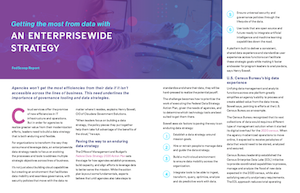- Sponsored
- Sponsored Content
Building a data strategy to improve decisions across lines of business

Agency leaders who want to gain greater insights from their data need to prioritize data integration and accessibility across their lines of business, says the CIO for a leading enterprise data services provider in a new report.
The White House Office of Management and Budget’s Federal Data Strategy 2020 Action Plan lays out processes for agencies to build capacity and utilize data more effectively. However, agencies still face the challenge of how to balance the requirements of the action plan with other IT priorities — and how best to implement data strategies in a secure and agile environment.

Read the full report.
What’s required is for agency leaders to establish an enterprisewide data strategy and develop governance policies that take evolving tools and processes into account, while addressing multiple strategic objectives, says Henry Sowell, CIO of Cloudera Government Solutions in the report.
“When leaders focus on building a data strategy, the policy pieces they put together will help them take full advantage of the benefits [of data management tools],” says Sowell. He also suggests that today’s advanced open source solutions give government greater long-term flexibility, regardless of how IT environments change, as evidenced by efforts at the U.S. Census Bureau.
Data lakes in action
The U.S. Census Bureau’s efforts to modernize its backend data management systems are cited in the report as being instrumental to the agency’s move to digitize the collection of 2020 census data.
Agency leaders recognized that the vast collection of data would require a modern management solution to generate insights that inform a wide range of decisions at all levels of government.
When the bureau started its digital overhaul, it established the Census Enterprise Data Lake (EDL) initiative. The end goal, according to the report, was to “provide coordinated capabilities to process, manage and analyze the flood of new data, while also satisfying security and privacy requirements.”
The Census Bureau uses Cloudera’s HDP (Hortonworks Data Platform) in its suite of tools to help mine, process and extract data it collected.
Additionally, improvements where made with its analytics tools that helped the agency easily clean its data by cross-checking with existing administrative records.
Overall, these efforts helped the bureau reduce redundant data collection, yielding better information to government decision makers, all while reducing total operating costs throughout the agency’s business operations.
Putting the data pieces together
While many agencies have point solutions to manage data during its lifecycle, Sowell says that modern data management platforms are built to deliver a consistent, standardized user experience across functions.
A unified cloud data platform will lower operational costs, he adds, because it encompasses the lifecycle of data management in one tool — including data capture, data movement, data engineering, data science and data storage.
It’s not just about integrating cloud-based tools but creating an environment that facilitates data mobility and seamless governance, with security policies that move with the data no matter where it resides, explains Sowell.
To build a strategy that is both enduring and flexible, Sowell says leaders should focus on six factors:
- Establish a data strategy around mission goals.
- Hire or retrain people to manage data and guide the data strategy.
- Build a multi-cloud environment to ensure data mobility across the organization.
- Integrate tools to be able to ingest, transform, query, optimize, analyze and do predictive work with data.
- Ensure universal security and governance policies through the lifecycle of the data.
- Use tools that are open source and future-ready to integrate artificial intelligence and machine learning capabilities down the road.
Sowell explains how Cloudera’s Shared Data Experience (SDX) platform facilitates the large-scale exchange of information, resulting in faster analysis, while also assuring consistent security and governance across any cloud or on-premise environment.
SDX allows data managers to set security and governance policies once and apply them across all data workloads. Those policies stay with the data even as it moves across all supported infrastructure, Sowell explains.
“Enterprisewide layers of data security with technologies such as Cloudera’s SDX provide tools that make an agency’s enterprise data cloud secure by design,” says Sowell.
Read more about creating an enterprisewide data strategy for better insights and security.
This article was produced by FedScoop and sponsored by Cloudera.






